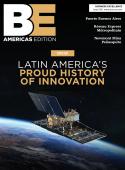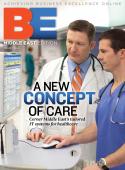Road ready┬áThe new Powertrain Engineering Development Center at General Motors offers high-tech testing cells combined with modern energy management and green design, Linda Seid Frembes finds out. As the worldÔÇÖs largest automaker, General Motors Corporation (GM) knows a thing or two about cars. Founded 100 years ago, the company is headquartered in Detroit and employs approximately 266,000 people worldwide. At GMÔÇÖs Powertrain Engineering Development Center in Pontiac, Michigan, the tradition of thorough research and testing of new technology continues in what is now the largest and most technically advanced powertrain development center in the world.The new 450,000-square-foot facility is purpose-built for powertrain development worldwide. Previously, GM had four facilities located in Michigan that were geographically spread out and outfitted with old technology. ÔÇ£The oldest testing facility was pushing 50 years old, so instead of renovating each one, GM wanted to consolidate them in a new facility under one roof,ÔÇØ says Marty Foster, project manager for GMÔÇÖs Worldwide Facilities Group (WFG), Capital Projects.Development activities at the center include testing on new engines and prototype engines, with different fuels and in different driving conditions. Testing is also conducted on transmissions in simulated driving conditions. Test cells are equipped to handle one-cylinder engines up to eight-cylinder racing engines, as well as hybrid and diesel engines. ÔÇ£The facility was designed to meet global demand for testing and development; this is what drove the size of the facility,ÔÇØ says Foster, who notes that $100 million was spent on the centerÔÇÖs mechanical systems alone.The test cells are used for complete development and testing of entire powertrains. GMÔÇÖs test cells are blast-proof and feature two- and three-hour fire-rated construction. The facility also features windowless dyno test cells with camera systems for safe viewing. ÔÇ£The facility was built to operate seven days a week, 24 hours per day,ÔÇØ says Walt Enczur, construction group manager for GMÔÇÖs WFG, Capital Projects.The new center is expected to improve the companyÔÇÖs powertrain efficiency by 50 percent on many lab procedures. The adoption of a compressed air pallet system and the creation of a prep area in the test wing have reduced the changeover time from 24 hours to 20 minutes. The compressed air pallet system also means that one technician can move up to four tons of equipment at once. ÔÇ£We can now assemble the engine outside the test cell and roll it in rather than building it in the cell,ÔÇØ explains Enczur. ÔÇ£The test cells also include quick-connects for water and flexible air ducts to accommodate any setup.ÔÇØAdditional throughput is achieved by test cell lights (red/yellow/green) that indicate the current test mode in each cell. ÔÇ£You can stand in one spot in the hallway and see the status of each cell,ÔÇØ says Enczur.The flexibility and efficiency of the new development center are in line with GMÔÇÖs Road-to-Lab-to-Math initiative that transitions testing from an actual vehicle to lab and computer-aided analysis. Controlled laboratory tests reduce the amount of physical vehicle tests.To handle the potential emissions pollution from the busy development center, four regenerative thermal oxidizers (RTOs) capture engine exhaust and clean the carbon monoxide and unburned hydrocarbon before releasing it into the environment. According to GM, the RTOs have reduced carbon monoxide emissions by at least 96 percent. GM is also careful to avoid any pollution from engine fuel. According to GM, all fuel and transmission fluids purged from test engines and transmissions are reclaimed in waste storage tanks.┬á Reuse is a major theme at the development center, where all substations and non-fluorescent lighting are reused from other closed GM facilities. Approximately 50 percent of medium-voltage cable is also reused. ÔÇ£Many of the green features implemented at the center were standard within the Worldwide Facilities Group. There were initiatives in existence across the company,ÔÇØ says Foster. ÔÇ£Green initiatives make sense in terms of payback in maintenance costs.ÔÇØAn onsite central energy plant delivers the power utilities used in the centerÔÇÖs test cells and is managed through a cooperative management system between GM and DTE Energy. According to GM, up to 15 percent of the centerÔÇÖs power is recycled energy generated in-house.┬á┬áEfficiency and cost savings were realized in the design and build phase using 3-D modeling. ÔÇ£The 3-D math model is new to the construction industry. Similar to AutoCAD, the model showed all the equipment, pipes, electrical and steel in a 3-D computer simulation,ÔÇØ says Foster. ÔÇ£You can see right away when something doesnÔÇÖt fit and change the design. So when the contractor installs something onsite, they can do it once and it fits. As a result, the parts are fabricated and assembled in a controlled quality environment at the contractorÔÇÖs location and shipped just in time to the site for installation.ÔÇØSteel fabricator Bristol Steel followed this efficiency model and delivered just in time as steel was erected each day. As a result, the steel for the center was erected in five to six months. ÔÇ£The 3-D math model probably shaved six months off the total construction time,ÔÇØ says Foster. ÔÇ£On a design/bid/build project, 10 to 15 percent in contract changes due to engineering errors and omissions is common in the industry. We had less than 1 percent in changes.ÔÇØConstruction began in October 2006 and the center recently dedicated the first testing wing in July 2008.Consumers looking forward to the Chevrolet Volt extended range electric vehicle should note that its electric drive unit, motors, power electronics and engine will be tested at GMÔÇÖs Powertrain Engineering Development Center.┬á









